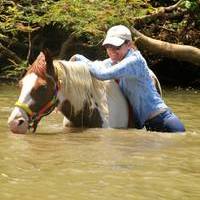
Are You & Your Horse Ready For Bitting Advice? The Steps You Need To Consider First
Equestrian Advice & Guides All Disciplines
Build your business profile for FREE and expose your services to thousands of potential clients!
Create my profile now!
I was working with a client recently, and a whole new can of worms opened up. I’m sure she’ll know who I’m talking about as I write – an experienced horse person with a sensitive, non-conforming mare who throws up challenge after challenge. The human was worried that she didn’t have the equine skills or the time to commit to helping the mare, and the mare… Well, she was just stressed and anxious.
The first day, when she arrived (in a halter) at the arena to be saddled to begin work, she was head high, flicking and twirling her nose, big eyes, holding her breath. We spent half an hour playing on the ground, where she displayed every textbook reaction – hesitation, lack of proprioception, tense jaw, looking away – not there, not real, not there, not real. And then – sigh – then she was there, and we could ride and play and explore. Second session, later on the same day, she was so much more relaxed, and by the following morning, she was waiting at the paddock gate to come and play. Four sessions, and each time a braver, more confident, more relaxed mare came along to play.

The human and I had a long conversation about the mare. Did she need skillful riding, handling, or hour upon hour of work? No. What the mare craved, and the only thing that will genuinely help, is for her humans to show up. That simple, just to be predictable and to show up.
We made a plan – every day, they’d show up. Maybe it would be with a halter in her paddock to do some very basic groundwork. Maybe it would be over a pole, or with a rope halter and a lunge line to move up and down the slopes of her paddock. Maybe it would be with tack to hack, or play, or go and school, but the humans would show up, and let the mare know that they were around and dependable. Yes, the mare is a little complex, there are some physical issues, but what she needs now is time to trust her people.
Many, many years ago, I had a little, skinny, rescue mare arrive with the most horrendous sand colic. She lay on the floor for two weeks. The grooms and I were always with her – rolling her over, syringing coke and yogurt down her throat, and often the vet would arrive and sit in her stable for a while. He explained, there was nothing that he could really offer, except pain relief. The colic was not operable. It couldn’t be treated; all we could do was wait to see if the sand all passed through. Every morning I phoned the vet practice and said come and put her down. And then half an hour later, I’d say, lets give her one more day. A client of mine did a lot of reiki, energy work etc., and said she couldn’t help, because the pony had just decided that she wanted to die and there was nothing to be done. That was the feeling I had every time I looked at her, but as stubbornly as she wanted to die, I was stubborn about trying to save her. And, you know who saved her? It was the kids who all rode in the riding school. They’d sit in her stable and do their homework, read her books, tell her about their geography or history, or science project. The thing that saved her, was that the humans kept showing up. She wasn’t on her own, she started to trust people, and one day she decided to live, got up, and carried on. And for her whole life, she adored kids.
A good friend of mine was an animal communicator. She believed whole heartedly that horses can choose to pull the plug. If they don’t want to stick around, they can get colic. Whether or not you believe that it is quite so deliberate, horses that are stressed and living anxiously do get colic more often. And relaxed, happy horses, those who live in herds, who are “real” horses, (not barbie dolls living in pretty cages and never getting dirty), and those who are confident and well adjusted to interacting with humans, tend to be healthier.
Horses do need their basic needs met – they need forage, freedom, friends. And, once their base needs are met, the humans dealing with them do need a level of skill to keep everyone safe and happy, but the thing that a domesticated horse needs the most? They need a human to show up, to try and speak horse, to interact, to be trustworthy. They need consistency, and if they (the horse) are showing up at the paddock gate to come and play, they at least need the human to show up and say hello, thank you for coming.
As a horse owner you should keep asking yourself, how consistently do I show up in my horse’s life? Is it all or nothing? Blowing hot and cold? Or can they trust that I’ll keep pitching up to play, doing my best for them?

